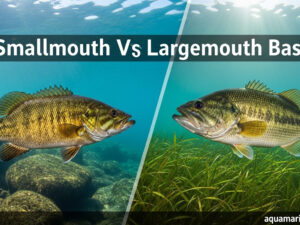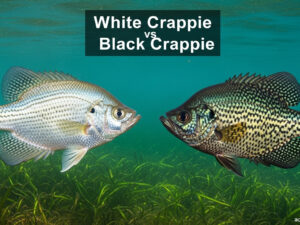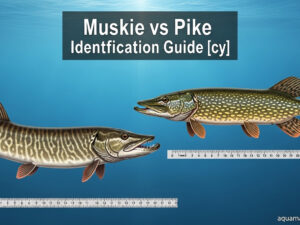Vermilion snapper and red snapper represent two of the most sought-after species in Gulf waters, yet many anglers struggle to tell them apart. While both fish share similar reddish coloration and overlapping habitats, vermilion snapper (also called b liner snapper) are typically smaller with distinctive yellow diagonal lines and more forked tails, whereas red snapper grow much larger with uniform crimson color and straighter tail edges.
Understanding these differences is crucial for regulatory compliance, as the species have different bag limits and seasons. This comprehensive guide covers everything from vermilion snapper facts to identification pictures, helping you distinguish these valuable gamefish with confidence.
Quick Identification: Vermilion Snapper vs Red Snapper
The most reliable way to distinguish vermilion snapper vs red snapper begins with size and body shape. Vermilion snapper typically measure 12-18 inches and weigh 1-3 pounds, featuring slender, streamlined bodies built for speed. Red snapper grow substantially larger, commonly reaching 20-30 inches and 5-10 pounds, with some trophy specimens exceeding 40 pounds.
Key Physical Differences:
- Body Shape: Vermilion snapper have torpedo-like, slender profiles while red snapper display deeper, more robust builds
- Tail Shape: Vermilion snapper feature distinctly forked tails with sharp points; red snapper have straighter, less forked tails
- Eye Characteristics: Vermilion snapper have oversized, bloodshot-appearing eyes; red snapper have smaller, pinkish-red eyes
- Mouth Size: Vermilion snapper have smaller mouths relative to body size; red snapper possess larger, more prominent mouths
These differences become more pronounced when comparing fish of similar sizes, making identification easier for anglers familiar with both species.
Vermilion Snapper Color Patterns and Visual Identification
Vermilion snapper color presents unique characteristics that set them apart from their red snapper cousins. The body displays a vibrant orange-red hue on the back, transitioning to silvery-pink on the sides and pale white on the belly. Most distinctively, vermilion snapper feature irregular yellow-gold diagonal lines running below the lateral line.
The fins provide additional identification clues. Their dorsal fin appears rose-colored with a bright yellow edge, while the caudal (tail) fin shows red coloration with a faint black margin. These vermilion snapper pictures details help anglers make positive identifications even when fish are similar in size.
Professional Identification Tip: The yellow diagonal lines on vermilion snapper are often wavy or zigzag patterns, unlike the straight horizontal lines found on lane snapper. This distinction becomes critical when regulations require precise species identification.
When looking at vermilion snapper vs red coloration, red snapper display more uniform crimson coloring throughout their bodies without the distinctive yellow markings. Their fins are typically solid red without the yellow edging characteristic of vermilion snapper.
Vermilion Snapper Habitat and Behavior Differences
Vermilion snapper habitat preferences differ significantly from red snapper, influencing where anglers encounter each species. Vermilion snapper thrive in depths between 80-350 feet around irregular reef structures, preferring to hover in open water above or adjacent to structure rather than hiding within it.
This behavior earned them the nickname "b liner snapper" - commercial fishermen would line the outer edges of fish boxes with these active swimmers while placing the more sedentary red snapper in protected interior spaces. The name also reflects their tendency to make straight, fast runs when hooked.
Red snapper, in contrast, prefer lurking within reef structures, wrecks, and rocky outcroppings. They're ambush predators that wait for prey to approach rather than actively hunting in open water like vermilion snapper.
Habitat Depth Comparison:
- Vermilion Snapper: 80-350 feet, preferring 120-200 foot range
- Red Snapper: 30-600 feet, with larger fish in deeper water
- Juvenile Overlap: Both species' young may be found in shallower waters
The Miami fishing piers often produce both species, particularly around deeper pier ends where natural and artificial reefs create ideal habitat conditions.
B Liner Snapper: Origin and Interesting Facts
The term "b liner snapper" originated from commercial fishing practices in the Gulf of Mexico. Commercial fishermen discovered that vermilion snapper's active nature made them ideal "liner" fish - they would swim along the edges of holding areas and could be easily accessed when needed.
Essential Vermilion Snapper Facts:
- Scientific Name: Rhomboplites aurorubens (meaning "golden-red rhombus-armed")
- Lifespan: Up to 15 years in wild conditions
- Maturity: Reach sexual maturity at 1-2 years old
- Spawning: Multiple spawning events from April-September
- Diet: Small fish, shrimp, crabs, squid, and planktonic organisms
- Speed: Faster swimmers than red snapper, hence "beeliner" nickname
These fish demonstrate remarkable schooling behavior, often forming large aggregations with other snapper species. Unlike red snapper that become increasingly solitary with age, vermilion snapper maintain their schooling tendencies throughout their lives.
According to NOAA Fisheries, vermilion snapper populations are currently not overfished in U.S. waters, making them a sustainable seafood choice for environmentally conscious consumers.
Fishing Techniques and Regulations
Successfully targeting vermilion snapper vs red snapper requires different approaches due to their behavioral differences. Vermilion snapper respond well to smaller baits presented in the water column above structure, while red snapper prefer bottom presentations near cover.
Vermilion Snapper Techniques:
- Use smaller hooks (size 2-6) to match their smaller mouths
- Present baits 10-30 feet above bottom structure
- Fresh squid strips work exceptionally well
- Light wire leaders prevent bite-offs from their sharp teeth
Current Regulations (2025):
- Federal Waters: 12-inch minimum, 10 fish per person
- State Waters: Varies by state, typically 10-12 inch minimum
- Season: Generally open year-round (check local regulations)
The liberal bag limits reflect vermilion snapper's abundance compared to heavily regulated red snapper fisheries. Many charter captains target vermilion snapper specifically to provide clients with action when red snapper seasons are closed.
Where to Find Vermilion Snapper for Sale
Vermilion snapper for sale can be found at seafood markets, specialty fish stores, and online retailers throughout coastal regions. Prices typically range from $8-15 per pound for whole fish, with fillets commanding premium pricing.
When purchasing vermilion snapper, look for:
- Bright, clear eyes without cloudiness
- Firm flesh that springs back when pressed
- Fresh ocean smell without strong fishy odors
- Intact scales with good coloration
Many sustainable seafood advocates recommend vermilion snapper as an excellent alternative to overfished species, offering similar taste profiles with lower environmental impact.
Taste and Culinary Comparison
Both species offer excellent table fare, though subtle differences exist in taste and texture. Vermilion snapper provides delicate, sweet flavor with medium-firm texture that flakes beautifully when cooked. The meat presents pure white color and holds together well during cooking.
Red snapper features slightly firmer texture with a mild, sweet flavor that's become the gold standard for white fish preparations. Its larger fillets make it more popular for restaurant presentations.
Cooking Recommendations:
- Vermilion Snapper: Excellent for ceviche, pan-searing, and whole fish preparations
- Red Snapper: Ideal for grilling, baking, and blackening applications
- Preparation Tip: Both species benefit from minimal seasoning to showcase their natural sweetness
Professional chefs often prefer vermilion snapper for delicate preparations due to its buttery texture and subtle flavor that doesn't overpower accompaniments.
Conservation Status and Sustainability
Vermilion snapper vs red conservation status shows significant differences. While red snapper populations have faced overfishing pressure requiring strict management measures, vermilion snapper stocks remain healthy throughout most of their range.
The National Marine Fisheries Service reports that South Atlantic and Gulf of Mexico vermilion snapper stocks are not overfished and not subject to overfishing. This sustainable status makes vermilion snapper an environmentally responsible choice for consumers.
Conservation Factors:
- Shorter lifespan allows quicker population recovery
- Higher reproductive rate than red snapper
- Less targeted fishing pressure historically
- Broader depth range provides refuge areas
Anglers can contribute to conservation by properly identifying species, following bag limits, and using descending devices to improve release survival in deep water fishing.
Expert Tips for Species Identification
Professional charter captains and marine biologists use these field identification techniques when distinguishing vermilion snapper and red snapper:
Size-Based Identification:
- Any red snapper under 16 inches is likely a vermilion snapper
- Fish over 6 pounds are almost certainly red snapper
- Use body proportions rather than absolute size when possible
Behavioral Clues:
- Fish hovering in open water above structure: likely vermilion snapper
- Fish hugging bottom structure: likely red snapper
- Schools of similar-sized fish: often vermilion snapper
- Solitary larger fish: typically red snapper
Advanced Identification Features:
- Anal fin shape: vermilion snapper have rounded anal fins; red snapper have more pointed anal fins
- Tooth patches: red snapper have prominent vomerine tooth patches on roof of mouth
- Scale patterns: subtle differences in scale shape and arrangement
Frequently Asked Questions
What's the main difference between vermilion snapper and red snapper?
The primary differences are size and markings. Vermilion snapper stay smaller (1-3 pounds typically) with distinctive yellow diagonal lines on their sides, while red snapper grow much larger (5-10+ pounds) with uniform red coloration and no yellow markings.
Why are vermilion snapper called b liners?
Commercial fishermen nicknamed them "b liners" or "beeliners" because of their behavior. They line the outer edges of holding areas and make straight, fast runs when hooked, resembling a "bee line" to cover.
Can you eat vermilion snapper?
Yes, vermilion snapper are excellent eating with sweet, mild flavor and firm white flesh. Many consider them equal to red snapper in taste and texture, making them a popular alternative.
Where do vermilion snapper live?
Vermilion snapper inhabit depths of 80-350 feet around reefs, wrecks, and rocky structures throughout the Gulf of Mexico and Atlantic coast from North Carolina to Brazil.
How do you identify vermilion snapper pictures?
Look for orange-red backs with irregular yellow-gold diagonal lines below the lateral line, forked tails, oversized eyes, and slender body shapes. These visual markers distinguish them from red snapper.
Are vermilion snapper sustainable to catch?
Yes, vermilion snapper populations are currently healthy and not overfished according to NOAA assessments, making them a sustainable seafood choice.
Conclusion
Understanding the differences between vermilion snapper and red snapper enhances both fishing success and regulatory compliance. While these species share similar habitats and appearance, key identifying features like size, coloration patterns, and body proportions make reliable field identification possible.
Vermilion snapper's smaller size, yellow diagonal markings, and forked tails distinguish them from the larger, uniformly red-colored red snapper. Their sustainable population status and excellent eating qualities make vermilion snapper an ideal target for anglers seeking action when red snapper seasons are restricted.
Whether you're planning your next offshore fishing trip or shopping for fresh seafood, this comprehensive guide provides the knowledge needed to confidently identify and appreciate these valuable Gulf Coast species. Remember to check current regulations before fishing and consider vermilion snapper as a delicious, sustainable alternative to heavily managed red snapper.
For more marine fishing insights and species identification guides, explore our comprehensive collection of saltwater fishing resources and conservation-focused seafood articles.



